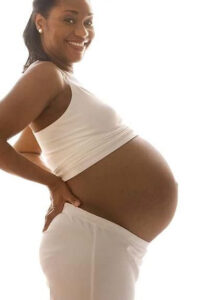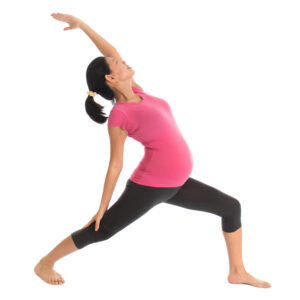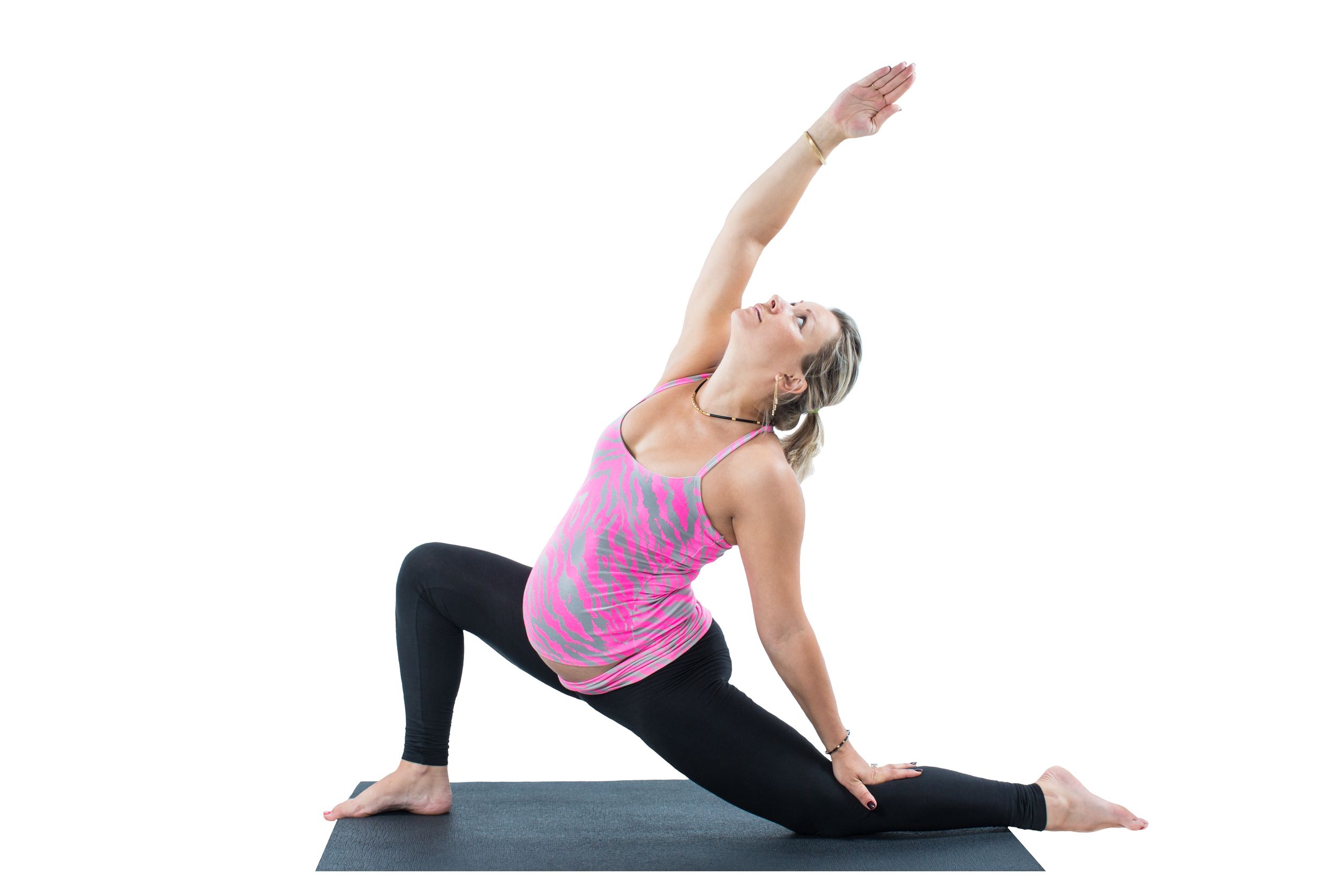As the weight gain of pregnancy accumulates more significantly in the second and third trimesters, you might be feeling some tightness or pain in different areas of your body — especially your low back, hips, and legs. Performing gentle stretches can be a great way to release tension and tightness in these areas. But what types of stretches are best? Are there certain stretches that should be avoided during pregnancy (such as those that involve twisting or lying on your back)?
We’ll answer all these questions in this post and share some of our very favorite stretches. Stay tuned till the end though for our most powerful strategy of all — one that can help alleviate most of these aches and pains in the first place.
NOTE — This post will focus on stretches that help release pain & tightness. For stretches that help prepare your body for childbirth, check out Mobility Exercises to Prepare for Birth.
Before we get into the stretches, let’s begin with a brief explanation of what causes the underlying pain & tightness, as having this knowledge might help you make some adjustments to prevent further aches and pains.
Two Key Causes of Pain or Tightness
It goes without saying that the body goes through A LOT of changes to grow a human in 40 weeks. However, there are three changes, in particular, that drive most of the pain & tightness you feel.
1. Weight Gain
Most of the weight gain during pregnancy is in your belly. This increased mass in the front of your body shifts your center of gravity up and out. This can often lead people to lean backward to counterbalance, which makes the muscles on the back side of the body — including your neck, back, and hamstrings — have to work harder. In addition, the growing belly tends to pull your body out of neutral alignment (an alignment state that minimizes the stress on your muscles, tendons, and ligaments). Specifically, it often tips your pelvis forward, which pulls your lumbar spine into extension — or an excessive low back arch — as you see pictured below. This places even more pressure on your low back. This can also lead to tightness in your hips and hamstrings.

2. Hormonal Changes
While there are a host of hormonal changes that occur, one key change is the increase in the hormone relaxin. Just as the name sounds, relaxin works to relax the joints, ligaments, and connective tissues to allow the body to adapt to carrying a growing baby, and to provide increased mobility for birth. However, this increased laxity in your body’s soft tissues tends to further exacerbate the shifts above, which can further increase the stress on your low back, hips, and legs.

Now that you understand the primary contributors to the pain & tightness you might be feeling, let’s cover a few stretches that can be very helpful in releasing some of this tension.
4 Great Stretches for Your Low Back, Hips, & Legs
For all the stretches below, take slow, deep breaths in the position — focusing on a long exhale to promote a release of tension in the muscles. You can spend two or three breaths in each position, and think of “melting” into the end ranges. Repeat for 2-4 reps per stretch, or as many as feels good to you!
1. Kneeling Hip Flexor & Hamstring Stretch
The front and back of the thighs often gets taxed with the increase in weight gain and would benefit from some lengthening. This kneeling stretch creates a little flow in your end ranges at the hips, but don’t be surprised if you also feel a lovely stretch down the front and back sides of your whole body—an added bonus!
2. Kneeling Side Stretch
We tend to neglect the sides of the body, but often if there is tightness in this area, the low back can jump in to compensate. So, it’s a good idea to release tension in the sides of your body to avoid placing even more pressure on your low back. To maximize this stretch, create the longest line possible between your pinky toe and pinky finger. In addition, you can play around with the angles by turning your chest towards the ceiling and then towards the ground.
3. Side-Lying Windmill
This stretch helps release tension in your mid-back (which is forced to work extra hard during pregnancy to counterbalance the increased load you’re carrying in front). After extending your arm fully to the opposite side, take a few slow, deep breaths in the position before bringing your arm back to the starting position.
4. Seated Figure-4 Stretch
This simple seated stretch is a deceptively effective way to open up your hip rotators — the areas on the outside of your hips that are working overtime, especially when you have to support yourself on one leg (like when walking, climbing stairs, getting up from the ground, etc.). Try to keep your spine neutral as you move forward (likely only a few inches will do the trick). NOTE: If you are experiencing symptoms of pelvic girdle pain, such as SI joint pain or SPD, do not perform this stretch because this type of deep, single-leg stretch could aggravate pain. See the articles on SI Joint Pain and Symphysis Pubis Dysfunction (SPD) for exercises and other tips to help prevent and address these different forms of pelvic pain.
Answering Your Safety-Related Stretching Questions
After seeing the stretches above, you might be thinking: Is it safe to twist or bend during pregnancy? Is it safe to lie on your back during pregnancy? The short answer, when it comes to stretching, is YES.
With regards to twisting and bending, once you develop a belly, you do want to avoid loaded movements (strengthening exercises) in these positions. However, unloaded movements (stretches) are perfectly fine. For more information, see Core Exercises to Avoid During Pregnancy and Is Twisting Safe During Pregnancy?
With regards to lying flat on your back during pregnancy, research has shown short periods on your back to be safe throughout pregnancy provided you are comfortable. For more information on this topic, and a full summary of what the research has shown for both shorter and longer durations in the supine position, see Can You Lie Flat On Your Back During Pregnancy?
The Most Powerful Strategy to Prevent Aches & Pains In the First Place
Now, we’ve come to the part we teased at the beginning of this article — the one strategy that can help far more than any stretch. The one strategy that can help you prevent most of the common pregnancy aches, pains, & injuries. The one strategy that can help you move with energy and ease right up until the very end of your term. Without further ado, that strategy is…drumroll please…😊
Strength Training!
Developing a stronger body will make it easier to carry around the extra body weight, mitigate the alignment shifts that can make you feel stiff, and increase your stability to help counteract the effects of relaxin. It’s simple. The stronger you are, the more your body is able to withstand the increased stresses from the physical and physiological changes of pregnancy.
To read more about the research-backed benefits of strength training — and learn 4 strategies for safe & effective strength training — see Your Guide to Strength Training During Pregnancy.
Get a Done-for-You Strength Training Program (or Learn How to Design One)
If you’re looking for a complete training program that will help you prepare your body for the unique stresses of pregnancy, childbirth, and the postpartum period, check out our self-guided training programs. Just select the program that’s right for you based on your stage when starting and the app will guide you through a comprehensive training program tailored to your stage to help you .
Are you a health & fitness professional? Explore our Professional Education. Select from our signature Pre/Postnatal Certification or our “Mini Course” for Group Fitness Instructors.
